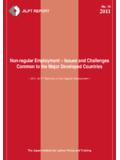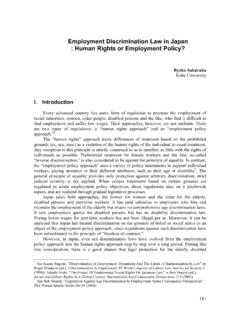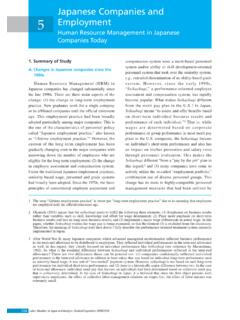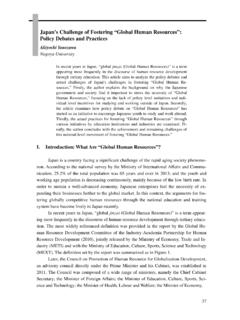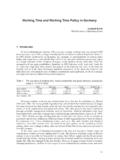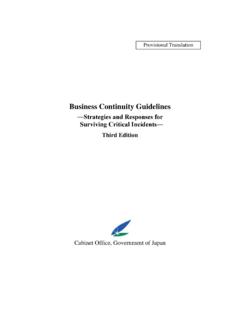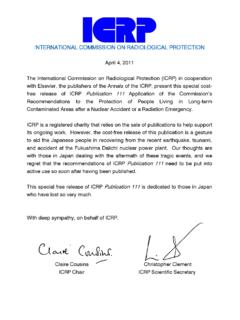Transcription of PRIVATE HEALTHCARE POLICY AND SYSTEM IN …
1 PRIVATE HEALTHCARE POLICY AND SYSTEM IN MALAYSIA AND japan : SUSTAINING HARMONIOUS WORKPLACE RELATIONS THROUGH GOOD GOVERNANCE AND BEST PRACTICES DURRISHAH IDRUS INTRODUCTION The article discusses on HEALTHCARE policies in japan and Malaysia, especially on the PRIVATE HEALTHCARE sector of the two nations, who now view HEALTHCARE industry as important economic contributors. While Malaysia aims to excel in medical tourism, japan hopes to expand globally. As a general rule, japan does not substantiate the role of PRIVATE HEALTHCARE as very different from the public HEALTHCARE , as the case is for Malaysia. japan has long been a role model for Malaysia, especially on work ethics, work culture, management and technology. The HEALTHCARE industry in japan is bigger, as compared to Malaysia, which now is given the task to steer the Malaysian economy from the middle income trap to a high income society.
2 In this article, PRIVATE HEALTHCARE providers refer to hospital and clinical setting scenarios and not the HEALTHCARE industry per se, where japan is the second largest drug and medical device market in the world. The discussion highlights the good governance and best practices that become the foundation for workplace relations that keep together people working at the HEALTHCARE industry. No matter how different we perceive it, or how different the experience was, without good workplace relations, organizations would be in crisis, as history of both countries attests to, and the development progress may be affected. The debate is that a good POLICY may make a difference to an economy of a country; at operational level, good working conditions, enabled by many factors, motivate workers and encourage them to stay at the workplace, either unionized or not. There are differences in terms of employment practices for both countries, which may trigger different consequences.
3 japan , before the 1990s, still honored lifelong employment, seniority based wages and enterprise unions. However, this type of labor management has changed since the bubble economy burst in early 1990s (Tatara, 2009). In Malaysia, it was also the same scenario, but the change is quite drastic now when young graduates do not mind durrishahJILPT 1. job hopping, prefer performance based salary and adopts human resource practices, instead of unionising. The study investigates at macro level, the practices and challenges PRIVATE HEALTHCARE scenario of Malaysia and japan , and in brief, the human resource practices through good governance and best practices. japan AND MALAYSIA'S ECONOMY japan economy has been reported to have experienced what is termed Lost Two Decades', from 1990 to until about 2010. Even now, japan is seen as still struggling to recover from the burst of the Bubble Economy, and it has never again enjoyed the robustness of the economy pre 1997.
4 Faced with three recessions, in 1997, 2000, and 2008, it was a very long way back for japan . Financial shrinkage resulted in cutting back of production and employment, which saw the unemployment rate arisen to in 2002 (Labor Situation, 2012). japan was proud to claim its distinguished identities in lifetime employment, seniority based wages, and enterprise based union, which was heavily emulated by Malaysia under the leadership of Tun Mahathir Mohamad, the Fourth Prime Minister (Jomo, 1994). Japanese work ethics, management style and technology were promoted under the Malaysian Look East POLICY , starting from 1983, until the end of his administration. However, japan , like the rest of the world who faced the economic challenge in the later part of 1990s has to resort to adaptable changes. Today japan is facing two distinct problems: ageing population and declining birth rate, both of which will have a profound impact on society and industry (Labor Situation, 2012; Health SYSTEM Review, 2009).
5 japan population is almost 128 million, approximately of world's population as compared to Malaysia's current 28 million. People in japan enjoy the longest life expectancy at birth in the world. Life expectancy at birth was 83 years in 2009 (for males it is , and for females, years respectively). This may have been contributed to affordable and better health care enjoyed by Japanese, coupled with healthy lifestyles. However, the forecast is not good for japan , as in 2050 the population will shrink to , while the proportion of the population aged 0 14 years will decrease to million, against an increase of population aged 65 years to durrishahJILPT 2. Nevertheless, even though the japan economy has been reported to be moribund, stagnant, shrinking ' (The Economist, 10 Sept 2011; Labor Situation, 2012; Health SYSTEM Review, 2009) to name a few, it is in fact, by comparison still better than most countries in the world.
6 Currently, japan is the third largest economy in the world behind the US and China ( ). japan may have lost its prized position but still highly strong and advanced in sectors such as manufacturing, especially in electronics and auto mobiles. Industry becomes 23% of japan GDP in 2010, with major industries include motor vehicles, electronic equipment, machine tools, steel and non ferrous metals, ships, chemicals, textiles and processed foods. In fact, after the 2008 global financial crisis, its economy showed strong period of recovery, with real GDP growth of , the fastest among the G 7nations for the year. It was the March 2011 earthquake and tsunami that brought back the derailment of the economic growth. japan was forced to downgrade its assessment of the economy, for the first time in six months. Meanwhile, Malaysia, a democratic monarchy like japan , comprises 13 states, has two different geographical regions; the Peninsular Malaysia, and Sabah and Sarawak on the Borneo Island, divided by the South China Sea.
7 Though a small economy, Malaysia at times is referred to as the Asian Dragon. In HEALTHCARE , Malaysia is now known as offering high end hospitals, especially PRIVATE run hospitals. Malaysian economy has also been affected by the Bubble Economy burst, but it recovered quite fast as compared to most Asian countries. In 2013, its economy is projected to grow by , which is the same pace as 2012. The Malaysian government, which, at the time of this writing is on the verge of dissolving its Parliament for the 13th General Election, has embarked on a very brave national government transformation plan (GTP), which includes the Economic Transformation Plan (ETP). Malaysia is well under way of its 10th Malaysia Plan, a five year plans that has started since right before Independence from the British in 1957. It is under the ETP within the GTP that PRIVATE HEALTHCARE has been identified as one of the twelve National Key Economic Areas (NKEA) to play key roles in the economy (Durrishah, 2012; The Edge 12 Feb 2013).
8 Malaysia has to transform its economy, which has been caught in the middle income trap, and under the risk of being overtaken by other faster growing nations such as Vietnam (Durrishah, 2012). durrishahJILPT 3. Table 1: Malaysia at a Glance 2009 2010 2011 2012 Population (million) Total Male Female Average Annual Population Growth Rate (%) Birth and Death ( per 1,000 population ) Crude Birth Rate Crude Death Rate Total Fertility Rate Life Expectancy (years) Male Female Gross Domestic Product (GDP) Employment Labour Force ('000) 11, 12, 12, 13, Employed ('000) 10, 11, 12, 12, Unemployment ('000) Labour Force Participation Rates, LFPR (%) Unemployment Rate (%) Source: Adopted from Department of Statistic, Malaysia, 2012. durrishahJILPT 4. According to Department of Statistic Malaysia, the country is in a better position. As seen in Table 1, Malaysians now live longer, GDP growth rate is higher and the unemployment rate is lower.
9 These are important index for Malaysia to move ahead, especially in meeting the objectives of HEALTHCARE as an economic endeavor. Both Malaysia and japan stresses on the important position of HEALTHCARE industry in their economy. For japan , it spends of its GDP on HEALTHCARE , below the OECD average, and offers good quality care to patients. (See Table 2 on japan health expenditure as compared to some other countries). japan has excellent health indicators, but with increasing demands from doctors and patients. The Japanese pharmaceutical market was worth almost US$100 billion in 2010. Malaysia, as discussed above, has laid a foundation for PRIVATE HEALTHCARE to assist the government in bringing up the status of the people to a high income society. Table 2: Source: Wikipedia: HEALTHCARE SYSTEM in japan durrishahJILPT 5. HEALTHCARE POLICY AND SYSTEM IN BOTH COUNTRIES japan By comparison, Japanese people have enjoyed and still are enjoying better and more affordable HEALTHCARE SYSTEM than Malaysians.
10 The Japanese government runs almost a welfare like SYSTEM , ensuring all citizens enjoy the coverage for HEALTHCARE , regardless of their economic standing, or either the entity is public or PRIVATE . Since all hospitals and clinics are regarded as not for profit organizations', it does not matter where patients get their treatment, either at PRIVATE or public hospitals, which is quite different in Malaysia. In Malaysia, people with insurance or coverage by employers seek treatment at better hospitals' which, almost automatically meant the various PRIVATE hospitals in the country. (For detailed discussion on japan Health SYSTEM , refer to Health Systems in Transition, Vol 11, No 5, 2009). In japan , health insurance is mandatory, but no penalty for those who do not want to take them (only about 10% of the japan 's population does not enroll). The SYSTEM is fundamentally a universal health insurance coverage whereby citizens can get insured under categories of national health insurance, workplace based insurance, or government managed health insurance SYSTEM (Masako, 2009; Matsuda, 2012).
